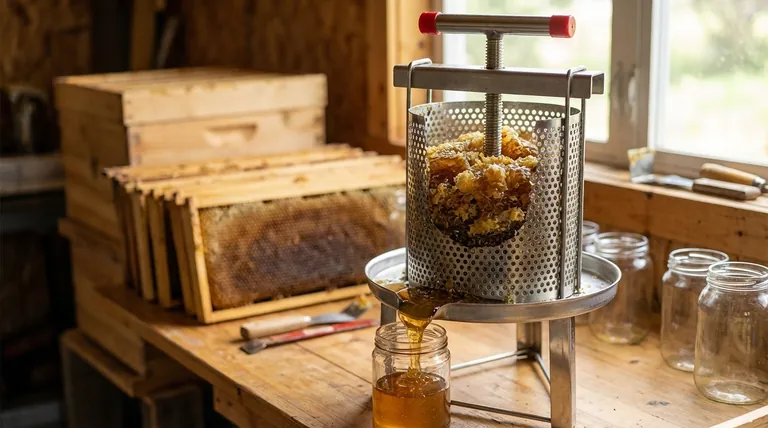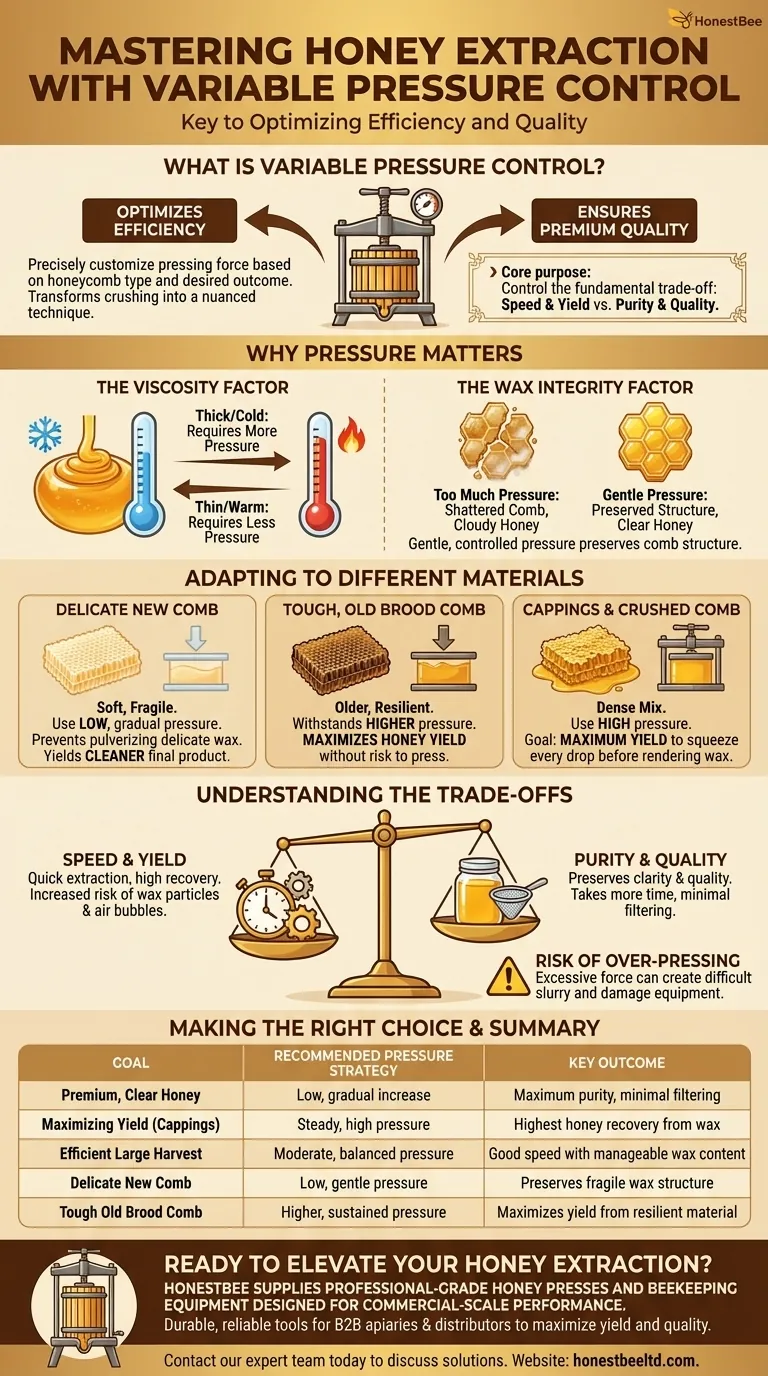Variable pressure control is the key to mastering your honey extraction. This feature allows you to precisely customize the pressing force based on the type of honeycomb and your desired outcome. It transforms the process from a simple act of crushing to a nuanced technique that optimizes both the efficiency of your extraction and the final quality of your honey.
The core purpose of variable pressure is to give you control over the fundamental trade-off in honey pressing: speed and yield versus purity and quality. It allows you to tailor the extraction process to the specific material you are working with, ensuring the best possible result for each batch.

Why Pressure Matters in Honey Extraction
A honey press works by applying force to separate liquid honey from the solid beeswax comb. The amount of force, and how it is applied, has a direct impact on the outcome.
The Viscosity Factor
Honey is a viscous liquid. Its thickness varies significantly based on floral source, moisture content, and temperature.
Colder or thicker honey (like that from heather) requires more pressure to flow out of the wax cells compared to warmer or thinner honey.
The Wax Integrity Factor
Honeycomb is a delicate structure. Applying too much pressure too quickly can shatter the comb into fine particles.
These wax particles become suspended in the honey, resulting in a cloudy product that requires more filtering and processing to clarify. Gentle, controlled pressure preserves the comb's structure.
Adapting to Different Materials
Not all comb is created equal. Variable pressure control allows you to apply the correct technique for the material you are processing, which is critical for achieving professional results.
For Delicate New Comb
Freshly drawn comb, especially from a super, is very soft and fragile.
Using a low-pressure setting and increasing it gradually allows you to gently squeeze the honey out without pulverizing the delicate wax, yielding a cleaner final product.
For Tough, Old Brood Comb
Comb that has been used for raising brood is older, darker, and more resilient due to accumulated cocoons and propolis.
This tougher material can withstand higher pressures, allowing you to maximize your honey yield. Variable control lets you apply that higher force without risk to the press itself.
For Cappings and Crushed Comb
Wax cappings, which are sliced off frames before extraction, are a dense mix of pure wax and rich honey.
For this material, high pressure is often desirable to squeeze out every last drop of honey from the wax. The goal is maximum yield, as the wax will be rendered separately anyway.
Understanding the Trade-offs
Variable pressure control is not about finding one perfect setting; it's about managing a series of trade-offs based on your goals for each batch.
Speed vs. Quality
The most significant trade-off is between speed and quality. High pressure extracts honey quickly but increases the risk of introducing wax particles and air bubbles.
Low, slow pressure application preserves the quality and clarity of the honey but takes more time.
Yield vs. Purity
Aggressively pressing at high pressure will extract the maximum possible amount of honey, increasing your total yield.
However, this often comes at the cost of purity, requiring more effort to filter and clean the honey later. A gentle press may leave a tiny amount of honey behind but produce a product that is nearly ready for bottling.
The Risk of Over-Pressing
Applying excessive force can completely obliterate the comb, creating a difficult-to-separate slurry of wax and honey. In extreme cases, it can also put undue stress on the press's frame, screws, or hydraulic components.
Making the Right Choice for Your Goal
Your ideal pressure strategy depends entirely on what you want to achieve with each batch.
- If your primary focus is premium, crystal-clear liquid honey: Start with low pressure and increase it very gradually, allowing the honey to flow freely before adding more force.
- If your primary focus is maximizing yield from cappings: Apply a steady, high pressure to reclaim as much honey as possible from the wax.
- If your primary focus is processing a large harvest efficiently: Find a moderate pressure that balances extraction speed with an acceptable level of wax contamination that you can manage with your filtering setup.
Ultimately, variable pressure control transforms your honey press from a simple tool into a precision instrument.
Summary Table:
| Goal | Recommended Pressure Strategy | Key Outcome |
|---|---|---|
| Premium, Clear Honey | Low, gradual increase | Maximum purity, minimal filtering |
| Maximizing Yield (Cappings) | Steady, high pressure | Highest honey recovery from wax |
| Efficient Large Harvest | Moderate, balanced pressure | Good speed with manageable wax content |
| Delicate New Comb | Low, gentle pressure | Preserves fragile wax structure |
| Tough Old Brood Comb | Higher, sustained pressure | Maximizes yield from resilient material |
Ready to Elevate Your Honey Extraction?
Mastering variable pressure is key to producing premium honey efficiently. For commercial apiaries and distributors, having the right equipment is essential for scaling operations and maintaining high-quality standards.
HONESTBEE supplies professional-grade honey presses and beekeeping equipment designed for commercial-scale performance. Our wholesale-focused operations ensure you get durable, reliable tools that maximize your yield and protect your honey's quality.
Contact our expert team today to discuss the best honey press solutions for your commercial beekeeping needs.
Visual Guide

Related Products
- Easy Use Manual Stainless Steel Honey Press for Honey Comb
- HONESTBEE 3-Frame Manual Acrylic Honey Extractor
- Stainless Steel 3 Frame Manual Honey Extractor Spinner for Bee Honey Extraction
- 10L Stainless Steel Honey Wax Press Extractor for Wax Cappings
- Electric Honey Press Machine for Squeezing Honey Comb Press Equipment
People Also Ask
- How does a honey press work? A Guide to Simple, High-Yield Honey Extraction
- What is a honey press and how does it work? A Guide to Crush-and-Strain Extraction
- What is the procedure for pressing honey? A Simple, Low-Cost Method for Small-Scale Beekeepers
- What are the two most popular types of machines for honey extraction? Choose the Right Tool for Your Apiary
- What are the reasons for choosing a honey press over a dedicated honey extractor? Maximize Disease Control and Natural Beekeeping



















